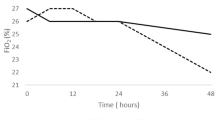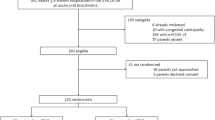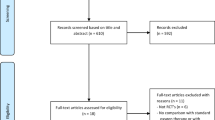Abstract
The objective of the current study is to compare the use of a nasal continuous positive airway pressure (nCPAP) to a high-flow humidified nasal cannula (HFNC) in infants with acute bronchiolitis, who were admitted to a pediatric intensive care unit (PICU) during two consecutive seasons. We retrospectively reviewed the medical records of all infants admitted to a PICU at a tertiary care French hospital during the bronchiolitis seasons of 2010/11 and 2011/12. Infants admitted to the PICU, who required noninvasive respiratory support, were included. The first noninvasive respiratory support modality was nCPAP during the 2010/11 season, while HFNC was used during the 2011/2012 season. We compared the length of stay (LOS) in the PICU; the daily measure of PCO2 and pH; and the mean of the five higher values of heart rate (HR), respiratory rate (RR), FiO2, and SpO2 each day, during the first 5 days. Thirty-four children met the inclusion criteria: 19 during the first period (nCPAP group) and 15 during the second period (HFNC group). Parameters such as LOS in PICU and oxygenation were similar in the two groups. Oxygen weaning occurred during the same time for the two groups. There were no differences between the two groups for RR, HR, FiO2, and CO2 evolution. HFNC therapy failed in three patients, two of whom required invasive mechanical ventilation, versus one in the nCPAP group. Conclusion: We did not find a difference between HFNC and nCPAP in the management of severe bronchiolitis in our PICU. Larger prospective studies are required to confirm these findings.


Similar content being viewed by others
References
Abboud PA, Roth PJ, Skiles CL, Stolfi A, Rowin ME (2012) Predictors of failure in infants with viral bronchiolitis treated with high-flow, high-humidity nasal cannula therapy. Pediatr Crit Care Med 13:e343–e349. doi:10.1097/PCC.0b013e31825b546f
Cambonie G, Milési C, Jaber S, Amsallem F, Barbotte E, Picaud JC, Matecki S (2008) Nasal continuous positive airway pressure decreases respiratory muscles overload in young infants with severe acute viral bronchiolitis. Intensive Care Med 34:1865–1872. doi:10.1007/s00134-008-1201-x
Collins CL, Holberton JR, Barfield C, Davis PG (2013) A randomized controlled trial to compare heated humidified high-flow nasal cannulae with nasal continuous positive airway pressure postextubation in premature infants. J Pediatr 162:949–954.e1. doi:10.1016/j.jpeds.2012.11.016
De Winter JP, de Vries MAG, Zimmermann LJI (2010) Clinical practice : noninvasive respiratory support in newborns. Eur J Pediatr 169:777–782. doi:10.1007/s00431-010-1159-x
Donlan M, Fontela PS, Puligandla PS (2011) Use of continuous positive airway pressure (CPAP) in acute viral bronchiolitis: a systematic review. Pediatr Pulmonol 46:736–746. doi:10.1002/ppul.21483
Dysart K, Miller TL, Wolfson MR, Shaffer TH (2009) Research in high flow therapy: mechanisms of action. Respir Med 103:1400–1405. doi:10.1016/j.rmed.2009.04.007
Essouri S, Durand P, Chevret L, Balu L, Devictor D, Fauroux B, Tissières P (2011) Optimal level of nasal continuous positive airway pressure in severe viral bronchiolitis. Intensive Care Med 37:2002–2007. doi:10.1007/s00134-011-2372-4
Evans J, Marlais M, Abrahamson E (2012) Clinical predictors of nasal continuous positive airway pressure requirement in acute bronchiolitis. Pediatr Pulmonol 47:381–385. doi:10.1002/ppul.21549
Frizzola M, Miller TL, Rodriguez ME, Zhu Y, Rojas J, Hesek A, Stump A, Shaffer TH, Dysart K (2011) High-flow nasal cannula: impact on oxygenation and ventilation in an acute lung injury model. Pediatr Pulmonol 46:67–74. doi:10.1002/ppul.21326
Hammer J, Numa A, Newth CJ (1997) Acute respiratory distress syndrome caused by respiratory syncytial virus. Pediatr Pulmonol 23:176–183
Hasan RA, Habib RH (2011) Effects of flow rate and airleak at the nares and mouth opening on positive distending pressure delivery using commercially available high-flow nasal cannula systems: a lung model study. Pediatr Crit Care Med 12:e29–e33. doi:10.1097/PCC.0b013e3181d9076d
Lampland AL, Plumm B, Meyers PA, Worwa CT, Mammel MC (2009) Observational study of humidified high-flow nasal cannula compared with nasal continuous positive airway pressure. J Pediatr 154:177–182.e2. doi:10.1016/j.jpeds.2008.07.021
Larrar S, Essouri S, Durand P, Chevret L, Haas V, Chabernaud JL, Leyronnas D, Devictor D (2006) Place de la ventilation non invasive nasale dans la prise en charge des broncho-alvéolites sévères. Arch Pediatr 13:1397–1403. doi:10.1016/j.arcped.2006.07.005
Lee JH, Rehder KJ, Williford L, Cheifetz IM, Turner DA (2013) Use of high flow nasal cannula in critically ill infants, children, and adults: a critical review of the literature. Intensive Care Med 39:247–257. doi:10.1007/s00134-012-2743-5
McKiernan C, Chua LC, Visintainer PF, Allen H (2010) High flow nasal cannulae therapy in infants with bronchiolitis. J Pediatr 156:634–638. doi:10.1016/j.jpeds.2009.10.039
Milési C, Baleine J, Matecki S, Durand S, Combes C, Novais AR, Cambonie G (2013) Is treatment with a high flow nasal cannula effective in acute viral bronchiolitis? A physiologic study. Intensive Care Med 39:1088–1094. doi:10.1007/s00134-013-2879-y
Milési C, Matecki S, Jaber S, Mura T, Jacquot A, Pidoux O, Chautemps N, Novais AR, Combes C, Picaud JC, Cambonie G (2013) 6 cm H2O continuous positive airway pressure versus conventional oxygen therapy in severe viral bronchiolitis: a randomized trial. Pediatr Pulmonol 48:45–51. doi:10.1002/ppul.22533
Saslow JG, Aghai ZH, Nakhla TA, Hart JJ, Lawrysh R, Stahl GE, Pyon KH (2006) Work of breathing using high-flow nasal cannula in preterm infants. J Perinatol 26:476–480. doi:10.1038/sj.jp.7211530
Thia LP, McKenzie SA, Blyth TP, Minasian CC, Kozlowska WJ, Carr SB (2008) Randomised controlled trial of nasal continuous positive airways pressure (CPAP) in bronchiolitis. Arch Dis Child 93:45–47. doi:10.1136/adc.2005.091231
Thorburn K, Ritson P (2012) Heated, humidified high-flow nasal cannula therapy in viral bronchiolitis–panacea, passing phase, or progress? Pediatr Crit Care Med 13:700–701. doi:10.1097/PCC.0b013e3182677456
Yoder BA, Stoddard RA, Li M, King J, Dirnberger DR, Abbasi S (2013) Heated, humidified high-flow nasal cannula versus nasal CPAP for respiratory support in neonates. Pediatrics 131:e1482–e1490. doi:10.1542/peds.2012-2742
Conflict of interest
The authors have no conflict of interest to declare.
Author information
Authors and Affiliations
Corresponding author
Additional information
Communicated by Patrick Van Reempts
Rights and permissions
About this article
Cite this article
Metge, P., Grimaldi, C., Hassid, S. et al. Comparison of a high-flow humidified nasal cannula to nasal continuous positive airway pressure in children with acute bronchiolitis: experience in a pediatric intensive care unit. Eur J Pediatr 173, 953–958 (2014). https://doi.org/10.1007/s00431-014-2275-9
Received:
Revised:
Accepted:
Published:
Issue Date:
DOI: https://doi.org/10.1007/s00431-014-2275-9




